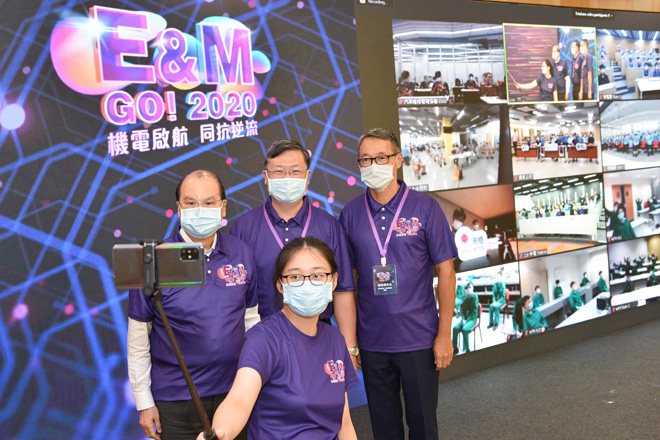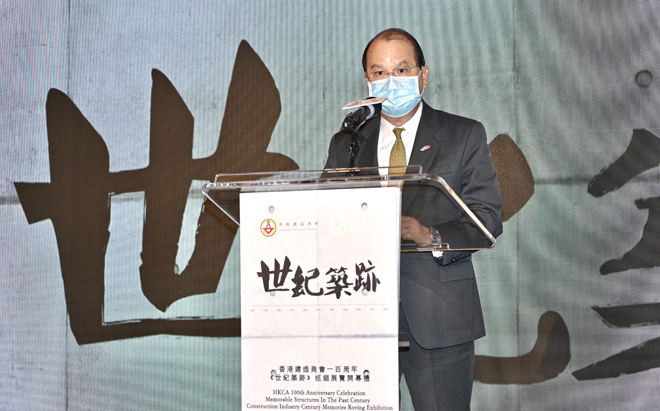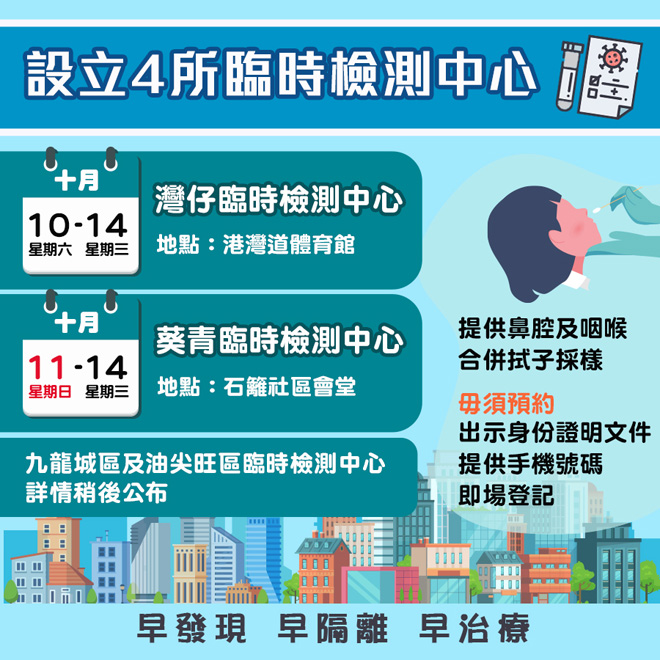Signs of COVID-19 resurgence
Proactively embrace challenges in achieving brighter future
11 October 2020

|

|

|

|
The recent surge in locally transmitted COVID-19 cases, including some with unknown sources of infection, has raised the alarm over a rebound of the epidemic. The situation is worrying.
There have been cluster infections and signs of small outbreaks involving a wide variety of settings, including bars, hotels, restaurants, schools and residential care homes for persons with disabilities. I would like to remind business operators to strictly observe anti-epidemic measures and the public to maintain social distancing and personal hygiene. We must not let down our guard.
To curb the epidemic, the Government has enhanced virus testing at the community level. We have, for example, extended the time for distributing deep throat saliva specimen collection packs at 46 general out-patient clinics. We have also set up temporary testing centres to provide convenient and free virus testing in districts with relatively large number of confirmed cases or infection clusters, namely Kwai Chung, Kowloon City, Tsim Sha Tsui and Wan Chai.
Thanks to the support of the Central Government, the community treatment facility expansion at AsiaWorld-Expo (AWE) was successfully completed and officially handed over to the Hospital Authority. Halls 8 to 11 now provide almost 1 000 additional beds, some of which are equipped with negative pressure facilities. This will greatly enhance our anti-epidemic capability and relieve the pressure on public hospitals. Also supported by the Central Government, the construction of a temporary hospital adjacent to AWE is expected to be completed within four months. Upon completion, it will provide negative pressure wards with over 800 beds and associated medical facilities.
It is the common wish of the people as well as the top priority of the Government to control the epidemic, revive the economy and maintain the long-term prosperity and stability of Hong Kong. In face of a complex external environment and a turbulent political climate, coupled with a persistent and volatile epidemic and deep-seated social conflicts, the Government will, under the leadership of the Chief Executive (CE), continue to brave the challenges. Taking a pragmatic and proactive approach, we will go all out to overcome difficulties and hurdles in order to revive our economy, improve people’s livelihood and enhance Hong Kong’s competitiveness in the long run.
Investing in education and nurturing talent
The future development of Hong Kong is dependent on the quality of talent. With this in mind, the Government attaches great importance to education and deploys substantial resources in this area. The total expenditure on education for 2020-21 is $112.3 billion. Of this, the recurrent expenditure has increased by 7.8% to $99.6 billion, accounting for 20.5% of the total government recurrent expenditure and taking up the largest share among all policy areas. The recurrent expenditure on education has increased by 16.4% within three years and even by nearly 80% within the ten years from 2011-12 to 2020-21.
To achieve balanced development of students and whole-person education, the Government has put in place various enhanced measures in respect of the primary and secondary school curricula, student support, relieving pressure on students, promotion of reading, as well as strengthening moral and civic education.
A gatekeeper to safeguard students’ interests
On the education front, it is imperative for the Education Bureau to play a gatekeeping role, while it is incumbent upon society to safeguard students’ interests and upon teachers to uphold professionalism. We should join hands to get education back on track and not allow schools to become the breeding grounds for twisted ideologies of “Hong Kong independence” and unlawfulness.
Education is an important and arduous mission. I deeply believe that most teachers are professional and mission driven. With students’ well-being as their prime concern, these devoted and caring teachers help students unleash their potential, grow up healthily, and eventually become good and responsible citizens, who will then contribute to the long-term stability of society and the country.
Caring for the grassroots and protecting labour rights
On the welfare front, the estimated recurrent expenditure on social welfare for 2020-21 is $93.9 billion, accounting for 19.3% of the total government recurrent expenditure, and is about $11.6 billion or 14.2% higher than the 2019-20 revised estimate of $82.3 billion.
The Government is implementing a series of improvement measures under the Comprehensive Social Security Assistance Scheme as announced in the CE’s 2019 Policy Address. These include substantially increasing the rent allowance, and relaxing the eligibility of a range of supplements and special grants. Also, all payment rates under the Working Family Allowance Scheme have been raised since July 2020.
The current-term Government takes employees’ rights and benefits seriously, and has made unceasing efforts to enhance support to and protection for grassroots workers taking into account the affordability of employers. One of the groundbreaking major improvements is extending the statutory maternity leave to 14 weeks. Employers may apply to the Government for reimbursement of the additional four weeks’ maternity leave pay subject to a cap of $80,000 per employee. Furthermore, the Government is pressing ahead with the preparation for abolishing the “offsetting” arrangement under the Mandatory Provident Fund Scheme, and has proposed to progressively increase the number of statutory holidays under the Employment Ordinance to align with that of general holidays. It has also improved the employment terms and conditions of non-skilled employees engaged by government service contractors.
Transitional housing projects on the go
In January this year, the CE announced the target of increasing the number of transitional housing units to 15 000. This is no easy task, which is achievable only with the continuous and concerted efforts of all sectors of the community.
Through the tripartite partnership of the community, business sector and the Government, three transitional housing projects, namely Nam Cheong 220, LST Housing (converted from Lok Sin Tong Primary School) and Transitional Rental Housing Scheme - Trackside Villas, were completed in the last quarter and have commenced intake of residents. Altogether, these three projects and the previous transitional housing projects provide over 1 100 units to relieve the pressure of families waiting for public rental housing and those living in unpleasant conditions.
To facilitate the implementation of transitional housing projects by community organisations, the Legislative Council approved a commitment of $5 billion on March 6 this year for the implementation of a funding scheme to support transitional housing projects by non-governmental organisations. The scheme has approved about $1.2 billion for three transitional housing projects since its launch in June this year.
Building infrastructure today for a better tomorrow
Hong Kong is an international cosmopolitan city with far-sighted planning and proactive infrastructure investment. Its infrastructure developments are not only widely recognised but also internationally renowned. In the World Economic Forum: Global Competitiveness Report 2019, Hong Kong was ranked world number three for infrastructure competitiveness. Our total investment in infrastructure is estimated to exceed $1 trillion in the next decade.
Hong Kong is committed to building new transport infrastructure, roads and high-speed rail links. The Hong Kong section of the Guangzhou-Shenzhen-Hong Kong Express Rail Link, connecting with the national high-speed rail network, was commissioned in September 2018; the Hong Kong-Zhuhai-Macao Bridge, connecting Guangdong, Hong Kong and Macao, commenced operation a month later in October; the Liantang Port/Heung Yuen Wai Boundary Control Point was opened in August this year; and the third runway and the whole three-runway system of the airport are expected to be completed in 2022 and 2024 respectively. All these developments will greatly enhance Hong Kong’s connectivity to the adjoining Guangdong Province, other Mainland provinces and cities, and even the rest of the world, bringing new opportunities for our future while functioning as significant propellers of economic growth.
Driving the economy with innovation and technology
Hong Kong has clear advantages in developing innovation and technology (I&T). The current-term Government has been committed to promoting the development of I&T and related industries, with a view to giving new impetus to the economy, improving the quality of life and creating quality jobs for young people.
The Government is pushing ahead with I&T development at full steam in accordance with the eight-pronged approach set earlier, including increasing resources for research and development, pooling technology talent, providing investment funding, providing technological research infrastructure, reviewing legislation and regulations, opening up government data, improving procurement arrangements, and strengthening popular science education. The Government has deployed substantial resources in this regard, and the financial commitment has already exceeded $100 billion. The various measures are gradually bearing fruits. With the concerted efforts of different parties, Hong Kong’s I&T ecosystem has become increasingly vibrant with the I&T atmosphere being consistently enhanced. In the World Digital Competitiveness Ranking 2020 published last week by the International Institute for Management Development, Hong Kong rose to world number five, the highest ranking achieved since the report was first published in 2017.
We are confident that Hong Kong will develop into a world-class I&T hub and smart city. We will keep on enhancing the local I&T ecosystem, consolidating and strengthening our advantages, boosting our innovation capability on all fronts, and expanding the local I&T talent pool with a three-pronged approach of nurturing, retaining and attracting talent.
Conclusion
Despite the multiple headwinds we have faced over the past three years, the current-term Government is making encouraging progress with initial achievements in areas such as education, welfare, labour, infrastructure and I&T. Moreover, a wide range of initiatives covering various policy areas are well underway.
Our future development will lead to both opportunities and challenges. To take Hong Kong forward, it is vital for us to have full support from the Central Government, understanding and trust from the general public, as well as dedication and contribution from the civil service. Together we will write a new chapter of thriving development for Hong Kong.

